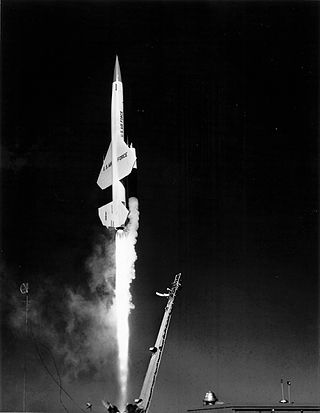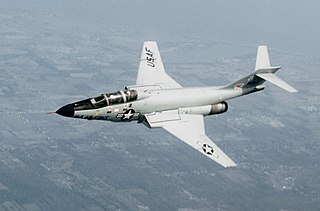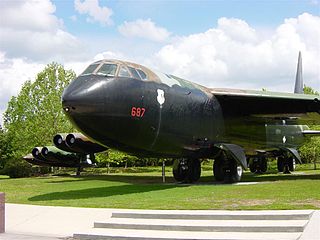
The Boeing CIM-10 Bomarc was a supersonic ramjet powered long-range surface-to-air missile (SAM) used during the Cold War for the air defense of North America. In addition to being the first operational long-range SAM and the first operational pulse doppler aviation radar, it was the only SAM deployed by the United States Air Force.

The Rockwell B-1 Lancer is a supersonic variable-sweep wing, heavy bomber used by the United States Air Force. It has been nicknamed the "Bone". It is one of the Air Force's three strategic bombers, along with the B-2 Spirit and the B-52 Stratofortress, as of 2024. Its 75,000-pound payload is the heaviest of any U.S. bomber.

Strategic Air Command (SAC) was a United States Department of Defense Specified Command and a United States Air Force (USAF) Major Command responsible for command and control of the strategic bomber and intercontinental ballistic missile components of the United States military's strategic nuclear forces from 1946 to 1992. SAC was also responsible for strategic reconnaissance aircraft; airborne command posts; and most of the USAF's aerial refueling aircraft.

The Douglas GAM-87 Skybolt was a hypersonic air-launched ballistic missile (ALBM) developed by the United States during the late 1950s. The basic concept was to allow US strategic bombers to launch their weapons from well outside the range of Soviet defenses, as much as 1,000 miles (1,600 km) from their targets. To do this in an air-launched form, a lightweight thermonuclear warhead was needed. Initially, the W47 from the Polaris missile was selected, but it was later replaced by the W59 from the Minuteman missile.

The General Dynamics F-111 Aardvark is a retired supersonic, medium-range, multirole combat aircraft. Production models of the F-111 had roles that included attack, strategic bombing, reconnaissance and electronic warfare. Aardvark comes from a South African animal that has a long nose and hugs the terrain. It is an Afrikaans word that translates literally as "earth pig" — hence the aircraft's "Pig" nickname during its Australian service.

The McDonnell F-101 Voodoo is a supersonic jet fighter designed and produced by the American McDonnell Aircraft Corporation.

The North American Aviation AGM-28 Hound Dog was a supersonic, turbojet-propelled, nuclear armed, air-launched cruise missile developed in 1959 for the United States Air Force. It was primarily designed to be capable of attacking Soviet ground-based air defense sites prior to a potential air attack by B-52 Stratofortress long range bombers during the Cold War. The Hound Dog was first given the designation B-77, then redesignated GAM-77, and finally AGM-28. It was conceived as a temporary standoff missile for the B-52, to be used until the GAM-87 Skybolt air-launched ballistic missile was available. Instead, the Skybolt was cancelled within a few years and the Hound Dog continued to be deployed for a total of 15 years until its replacement by newer missiles, including the AGM-69 SRAM and then the AGM-86 ALCM.

The McDonnell CF-101 Voodoo was an all-weather interceptor aircraft operated by the Royal Canadian Air Force and the Canadian Forces between 1961 and 1984. They were manufactured by the McDonnell Aircraft Corporation of St. Louis, Missouri for the United States Air Force, and later sold to Canada. CF-101s replaced the obsolete Avro CF-100 Canuck in the RCAF's all-weather fighter squadrons. The Voodoo's primary armament was nuclear AIR-2A Genie unguided air-to-air rockets, and there was significant political controversy in Canada about their adoption. Although they never fired a weapon in wartime, the CF-101 served as Canada's primary means of air defence from Quick Reaction Alert facilities at Canadian airbases. The CF-101s were retired in the 1980s and replaced with McDonnell Douglas CF-18 Hornet fighters. Many examples are preserved in museums and parks in Canada and the United States.

The AGM-86 ALCM is an American subsonic air-launched cruise missile (ALCM) built by Boeing and operated by the United States Air Force. This missile was developed to increase the effectiveness and survivability of the Boeing B-52H Stratofortress strategic bomber. The missile dilutes an enemy's forces and complicates air defense of its territory.

The AGM-129 ACM was a low-observable, subsonic, turbofan-powered, air-launched cruise missile originally designed and built by General Dynamics and eventually acquired by Raytheon Missile Systems. Prior to its withdrawal from service in 2012, the AGM-129A was carried exclusively by the US Air Force's B-52H Stratofortress bombers.

The Fairchild SM-73 was a planned sub-sonic, jet-powered, long-range, ground-launched decoy cruise missile. XSM-73 was the designation for the development version. Development began in 1952 with conceptual studies and ended when the program was canceled in 1958 after 15 test flights but before any operational deployment. The operational concept was to base squadrons of XM-73s at various locations in the United States and if necessary launch the aircraft as part of a strategic bomber attack. The aircraft would fly autonomously under inertial guidance towards the target area, using radar reflectors and electronic countermeasures to imitate American bombers and thus confuse and saturate enemy air defenses. The program was cancelled because the missile was not able to simulate a B-52 bomber on radar.

The ADM-141A/B TALD was an American decoy missile originally built by Brunswick Corporation for the United States Air Force and the Israeli Air Force. Later it transitioned to joint US/Israeli manufacture with Israeli Military Industries Advanced Systems Division (IMI-ASD).

The ADM-160 MALD is an air-launched, expendable decoy missile developed by the United States. It uses gradient-index optics to create a radar cross section that simulates allies' airplane, in order to stimulate, confuse, and degrade the capability of missile defense systems. Later variants (MALD-J) are additionally equipped with electronic countermeasures to actively jam early warning and target acquisition radars.

The Strategic Air Command & Aerospace Museum is a museum focusing on aircraft and nuclear missiles of the United States Air Force during the Cold War. It is located near Ashland, Nebraska, along Interstate 80 southwest of Omaha. The objective of the museum is to preserve and display historic aircraft, missiles, and space vehicles, and provide educational resources.

The Convair XGAM-71 Buck Duck was an air-launched decoy missile that was developed by Convair in the early 1950s. It was intended to have the same radar signature as the Strategic Air Command's B-36 bomber, thereby allowing it to disrupt the enemy's air defenses and dilute their effort to shoot down an incoming bomber fleet.
The Fairchild J83 turbojet was developed starting in 1955 to power cruise missiles used as un-armed decoys for bomber aircraft. The engine's development was terminated in November 1958.
The Convair XSM-74 was a subsonic, jet-powered, ground-launched decoy cruise missile.

The 306th Strategic Wing, previously the 306th Bombardment Wing, is an inactive United States Air Force unit. It was last assigned to the Strategic Air Command at RAF Mildenhall, Suffolk and was inactivated on 1 February 1992. The wing's mission was to coordinate all SAC air refueling and reconnaissance resources in the European Theater with the United States Air Forces in Europe (USAFE). It assumed the mission of the 98th Strategic Wing when that unit was inactivated in 1976.

The GAM-63 RASCAL was a supersonic air-to-surface missile that was developed by the Bell Aircraft Company. The RASCAL was the United States Air Force's first nuclear armed standoff missile. The RASCAL was initially designated the ASM-A-2, then re-designated the B-63 in 1951 and finally re-designated the GAM-63 in 1955. The name RASCAL was the acronym for RAdar SCAnning Link, the missile's guidance system. The RASCAL project was cancelled in September 1958.

The 822d Air Division is an inactive United States Air Force organization. Its last assignment was with Strategic Air Command (SAC) at Turner Air Force Base, Georgia, where it was inactivated on 2 September 1966.





















